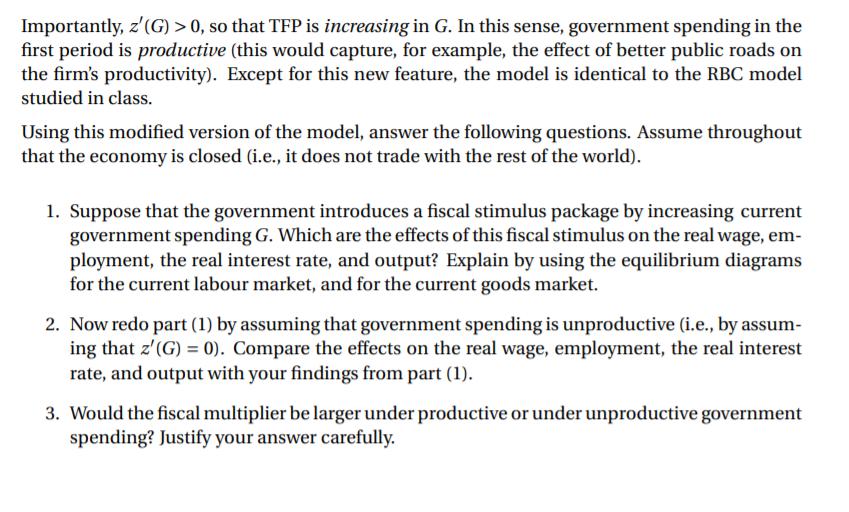Answered step by step
Verified Expert Solution
Question
1 Approved Answer
In the Real Business Cycle (RBC) model studied in class, it is assumed that government spending (either in the first or in the second


In the Real Business Cycle (RBC) model studied in class, it is assumed that government spending (either in the first or in the second period) is unproductive. In this problem you will analyse the implications of modifying that assumption. In particular, consider the RBC model with the following modification: Suppose that in the first period the representative firm produces output Y by operating the following technology: Y = z(G)F(K, Nd), where K denotes physical capital in the first period, Nd is labour demanded in the first period, and z(G) is total factor productivity (TFP) in the first period. Importantly, z'(G) > 0, so that TFP is increasing in G. In this sense, government spending in the first period is productive (this would capture, for example, the effect of better public roads on the firm's productivity). Except for this new feature, the model is identical to the RBC model studied in class. Using this modified version of the model, answer the following questions. Assume throughout that the economy is closed (i.e., it does not trade with the rest of the world). 1. Suppose that the government introduces a fiscal stimulus package by increasing current government spending G. Which are the effects of this fiscal stimulus on the real wage, em- ployment, the real interest rate, and output? Explain by using the equilibrium diagrams for the current labour market, and for the current goods market. 2. Now redo part (1) by assuming that government spending is unproductive (i.e., by assum- ing that z'(G) = 0). Compare the effects on the real wage, employment, the real interest rate, and output with your findings from part (1). 3. Would the fiscal multiplier be larger under productive or under unproductive government spending? Justify your answer carefully.
Step by Step Solution
★★★★★
3.33 Rating (159 Votes )
There are 3 Steps involved in it
Step: 1
1 If government spending G increases this raises TFP zG according to the assumption that zG 0 With h...
Get Instant Access to Expert-Tailored Solutions
See step-by-step solutions with expert insights and AI powered tools for academic success
Step: 2

Step: 3

Ace Your Homework with AI
Get the answers you need in no time with our AI-driven, step-by-step assistance
Get Started


